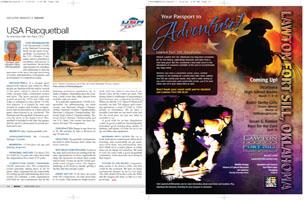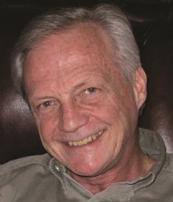
 |
| 2011 World Champion and Pan Am Gold Medalist Rocky Carson - Photo courtesy of Restrung Magazine |
Our organization: USA Racquetball (USAR) is the National Governing Body for the sport of racquetball, recognized by the U.S. Olympic Committee and is committed to excellence and service to our members. We provide opportunities for members and enthusiasts to actively participate in the sport, through sanctioning of events, administration of programs, and development of competitive teams.
Racquetball: Is a racquet sport played both indoors and outdoors. More people are familiar with the modern indoor version of the sport, which is played in health clubs, racquet clubs, community centers and more. The sport enjoyed explosive growth around the 1970s and 1980s, and today, is estimated to have about 5.6 million players. It is played by men and women in singles and doubles competitively, and recreationally, in a three-person game often referred to as 'cut-throat.' The International Racquetball Federation governs the sport on the highest level. Racquetball is included in the Pan-Am games, and the sport is showcased in several professional tours.
Website: http://usaracquetball.com
Headquartered in: Colorado Springs, Colorado
Members: 15,000-plus (all age and playing categories)
Personal history: I've been CEO of USAR for 10 years, but I have been with the organization for a total of 25 years.
Competitive event overview: USAR sanctions over 500 competitive events annually, taking place in all 50 states. State organizations are responsible for setting up and administering their own events; for example, a state organization will hold its own tournament and do the planning, promotion, registration, etc. to make it happen. Depending upon the location, a state event may draw players from multiple adjacent states.
As a national organization, USAR is responsible for administering six main events: our National Singles Championship, National Doubles Championship, National Collegiate Championship, National High School Championships, National Junior Olympic Championship and our U.S. Open. Our events can have between 300 and 750 competitors.
Our athletes: Range in age from six to 90. We actually do have a division for age 90 and over.
Facilities: Racquetball tournaments are held in clubs because that's where the most courts are.
Site Selection Process: Events at the state and local level are arranged by the state organizations, so those organizations make the decisions on where their events will be held. Events set up by USAR generally need a bigger venue. The biggest challenge at all levels is usually getting a facility that has enough courts.
Event Set-up: If we have an event with 300 competitors, we may need nine to 10 courts. That means we might need to work with two clubs in one area if one doesn't have all the courts we need. That always leads to challenges of negotiating a deal between two competing facilities. When we did the U.S. Open in Minnesota recently, we had 700 players and counting spectators, a total of 2,000 to 3,000 people in attendance. We do have a portable court that we can travel with, but for the most part, we just use what is available to us.
A good club for us has: Regulation courts in good condition, knowledgeable personnel, good viewing areas, plenty of parking, and plenty of room for us to set up our tables and equipment.
Working with cities: We try to work with sports commissions when we're traveling, and occasionally we get assistance from them, but unfortunately, they don't think we're a major player, so many times we do things for ourselves. We tend to look for cities with a good racquetball community. Some areas are very strong in that respect.
Future of the sport: Competitive play seems to be down a little, but that could be the economy. We have as many recreational players as we've ever had. The court owners tell us the courts are filled and the leagues are busy, so that is a very good sign.

